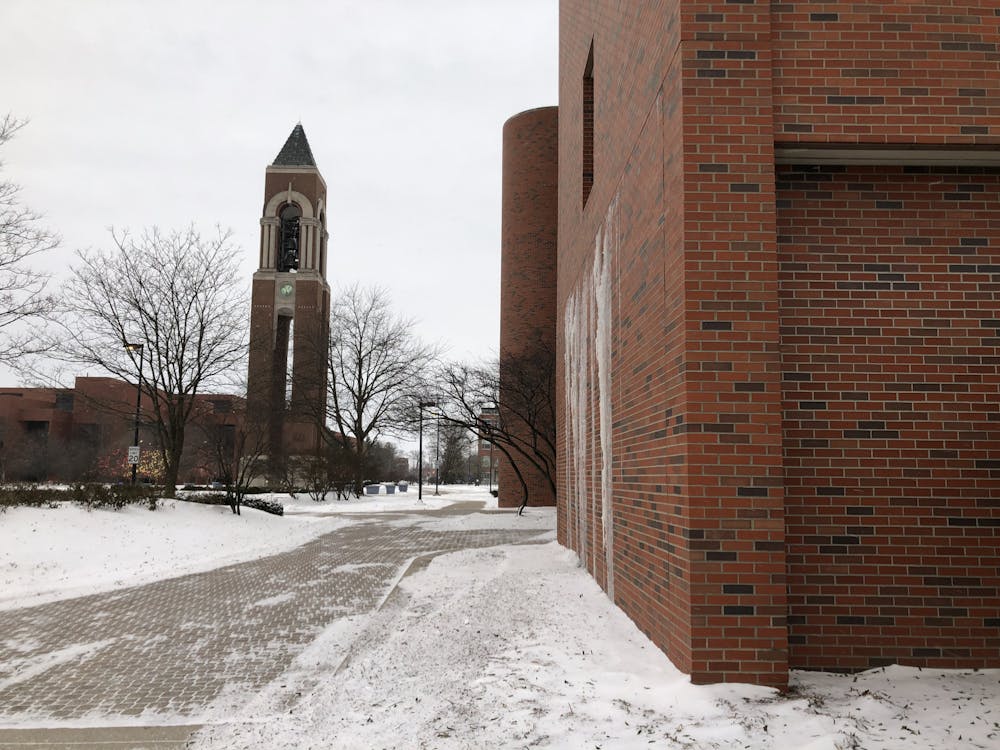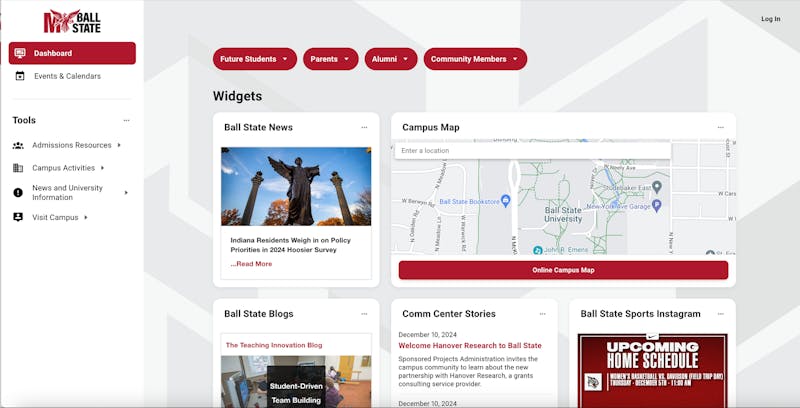Three to four inches of water. Baseboards ruined. Ceiling tiles broken. Pipes burst.
It was a heating system failure that caused Robert Bell to flood over winter break. The building uses a radiation-type heating system to keep it warm in the winter. This takes water that is heated through the pipes to then be radiated out into the room.
“There were three spots where the water in the pipes froze and expanded,” James Lowe, the associate vice president for facilities planning and management at Ball State, said. “It burst the pipe, and when it heats up, we have the water leak. It freezes, bursts, the pipe comes warm again, boom, water starts flooding.”
Lowe thinks because it was in three spots, one location might have caused the other two locations that were frozen to heat up and burst.
The flooding took place on the second floor where a majority of the English department offices are. Subsequently, the water flooded the second floor and ruined a good amount of ceiling tiles and baseboards on the first floor.
One of the staff members affected was Sean Lovelace, chair of the department of English and professor of English. His administrative office (RB 297) was damaged in the flood.
While eating on Christmas Day, Lovelace got a call from his dean, Maureen McCarthy. She said that Robert Bell was actively flooding. Lovelace received videos of the water inches high on the second floor.
“It really impacted the professors whose offices were on the second floor because you can imagine you come off the holidays, and you're preparing for the semester,” Lovelace said. “It just adds another stressor, like you can't get in your office. There are so many blowers and fans, they pretty much had to do their prep away from their offices.”
Even if some offices were flooded and caused a delay to prepare for spring semester planning, Lovelace couldn’t say enough how thankful he was for the people who helped solve the problems.
“I saw the people working over the Christmas holidays when I came here several times,” Lovelace said. “With the facilities and custodial people, we’re really grateful for their work.”

Deborah Mix, professor of English and assistant chair of programs, was also affected by the flood.
“We didn't have any personal items really in the assistant chair’s office, and so we didn't [lose anything],” Mix said. “The office is torn up, but we didn't lose anything.”
Mix said the walls were damaged from the bottom by about eight to six inches and accredited the staff and facilities for making things go as smoothly as possible.
Jill Christman, who is a professor in creative writing and director of the creative writing program, did lose some personal belongings. Christman is also the senior editor of two literary magazines, “River Teeth” and “Beautiful Things.”
“I had a stack of banker's boxes on one side because I didn't have enough room in my filing cabinets,” Christman said. “The bottom one collapsed, and because the water got to about a foot and a half high in there, once it collapsed, the rest of the boxes collapsed. I lost a lot of things. I lost a lot of books, but the thing that kind of broke my heart was that I had a box of files that were my files for when I first started teaching creative nonfiction, my very first classes here at Ball State back in 2002.”
Christman has three offices in Robert Bell. One is her personal faculty office in RB270, an office for the director of creative writing in RB282 and lastly RB283, an immersive-learning office where most of the work goes on for the literary magazines.
Christman said she has been continuing to teach her classes with as much energy, enthusiasm and humor as she can. Nevertheless, it has been a challenge.
Ball State officials hired Hays and Sons, an outside contractor, to deal with the situation.
“They have more fans and humidifiers than we have,” Lowe said. “They provide us with service when it goes beyond our normal complement of fans and dehumidifiers before we started the cleaning process.”
The first priority for Lowe and the department was to ensure classrooms were ready to go and usable when school started Jan. 9. The second goal was to work hard to ensure faculty offices were being put back together, so they were usable again.
Lowe said it is too early to tell how much the damage will cost.
This is not the first flood in Robert Bell. In early November 2018, there was another, that time on the fourth floor, but also coincided with ceiling tiles on the third floor being damaged and falling through, similar to the most recent flood.
The incident in 2018 was due to a contractor who was testing exterior fire hydrants along McKinley Avenue. It caused pressure in the pipes leading into the building, and the ruptured section was within Robert Bell.
“For us, a 1984-86 building isn't all that old,” Lowe said, referring to Robert Bell. “When we renovate, which we will someday down the road, it could be years and years from now, we will certainly look at a more robust heating system for that building, but I don't believe it was because of the age of the system. It was just incredibly cold.”
Contact Elijah Poe with comments at elijah.poe@bsu.edu or on Twitter @ElijahPoe4.





The Daily News welcomes thoughtful discussion on all of our stories, but please keep comments civil and on-topic. Read our full guidelines here.